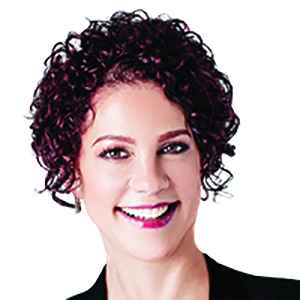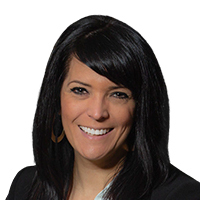Q&A with Klick Health’s Amy Gomez and Samantha Dolin on “Rise Above COVID”
Med Ad News spoke with Klick Health’s Amy Gomez, senior VP, diversity strategy, and Samantha Dolin, executive creative director, about the agency’s “Rise Above COVID” cross-cultural marketing campaign for the ACTIV-2 trial. They delve into the thinking of the campaign’s newly launched pilot program in three U.S. cities to reach out to communities of color, through Black-owned barbershops and salons.
Med Ad News: Please explain more about the ACTIV-2 trial and Klick’s involvement in it. Why was Klick chosen to create this campaign?
Amy Gomez: Right now I don’t have to tell you that vaccines are taking up all the airspace. But even though there are vaccines available now, people are still falling ill and dying from COVID-19, and that’s the problem that this trial is seeking to resolve. From the very first time we spoke with the leaders of this study, even before they engaged with us as their creative AOR, they were really stressing the importance of recruiting within the communities of color that have been so disproportionately affected by COVID-19, in terms of illness and terms of death.
And what they told us, when we started working with them, was that they really appreciated our integrated cross-cultural marketing capability and our integrated approach. So not only did we have a deep understanding of the multiple barriers that people of color face around clinical trials – among them, the history of unethical testing that created deep mistrust of the medical establishment, and lack of knowledge about clinical trials, because historically life sciences have not recruited in communities of color. And in all of this, there are systemic barriers, like transportation, and lack of paid time off.
But what was just as important to them is our ability to tap into core values and beliefs that are critical to help overcome these barriers. These are values such as personal empowerment, and community sensibility that are really at the core of our creative materials.
Med Ad News: What are the distinguishing characteristics of the ACTIV-2 trial campaign?
Samantha Dolin: We knew that while our program needed to cast a relatively wide net, we needed to make sure in particular that we were really connecting and resonating with the black and Hispanic communities. We really needed to make sure that we were coming up with something that would feel hopeful, that would feel empowering, that would give people a real reason to want to become involved.
The campaign we landed on is what we refer to as “Breakthroughs Waiting to Happen.” So much of what we were trying to do is help shift people who have fallen ill from COVID from the position of being a victim to one of feeling more empowered and being more of a victor if you will. If you think about it, prior to the ACTIV-2 trials becoming available, people were really reduced to hoping and praying and being isolated with their fears. Their only strategy was to hope that they could get through to the other side.
And the ACTIV-2 trials now, as they are looking for treatments to address active COVID-19 infections, they actually now, for the first time, offered a potential for a solution. And that’s something that was really, really exciting, something that now offered a critical link to life-restoring treatment. Something that could actually help all of us, the individuals but also at the community level, actually break through and ultimately rise above COVID, which became our handle for this whole movement. You’re seeing people portrayed in a more confident and heroic kind of stance. [They’re] shifting from being cast as simply a COVID-19 patient, to being illustrated as a breakthrough waiting to happen, as that real kind of catalyst for meaningful change. And while we were really wanting to make sure that we were connecting at the individual level – and giving people that sense of action and hope for themselves – we also wanted to make sure that we were connecting the idea that this was also about many people, That we can rise above COVID, but we can’t do it without the individual. It all starts with you but all of us together can make a meaningful change in finding a treatment that will help us all rise above COVID.
So our campaign from a cross-cultural perspective, we really wanted to make sure that we were getting a variety of people represented and evolve the language. But also for Hispanic and Spanish-speaking communities, making sure that we were really nuancing our communications to have those key thoughts feel true and resonate with them.
 Amy Gomez: I talked earlier about having our core values, and the cornerstone of our cross-cultural marketing practice is that it’s an insight-driven strategic discipline that relies on integrating deep insights. So if you think about one of the key features of the Latino mindset is community, it’s that community sensibility, it’s that viewing the world through the perspective of “we” and not “me” – my extended family, my community. … [and in the campaign] that sense of personal empowerment is so important – “I’m not a victim, I have agency to do something that will not only get me better but will hopefully heal my community.”
Amy Gomez: I talked earlier about having our core values, and the cornerstone of our cross-cultural marketing practice is that it’s an insight-driven strategic discipline that relies on integrating deep insights. So if you think about one of the key features of the Latino mindset is community, it’s that community sensibility, it’s that viewing the world through the perspective of “we” and not “me” – my extended family, my community. … [and in the campaign] that sense of personal empowerment is so important – “I’m not a victim, I have agency to do something that will not only get me better but will hopefully heal my community.”
Med Ad News: You’ve touched on how you are reaching out to the Latino community, how are you reaching out to the Black community in this campaign, and overcoming that deep sense of distrust of the medical establishment?
Amy Gomez: We’re doing this in a couple of ways, because trust is something that isn’t once and done, it gets built incrementally – one news article at a time, and one conversation at a time. We knew that an earned approach to multicultural media was going to be important, because Black media for example, or Hispanic media, offers that trusted “by us, for us” voice that mainstream media can’t offer. We’ve done a lot of earned media outreach, we’ve secured some significant coverage.
But that’s just one piece of it. Another piece, and we’re really excited about this new component of the program, that we just launched two weeks ago, we have a grassroots program [with Wil Shelton of Wil Power Integrated Marketing] focused on Black-owned barbershops and salons. We’re partnering with the shop owners who are very respected community entrepreneurs, and we’re leveraging their trusted voice of authority and leveraging that kind of “sacred space” of the barbershop or salon. We’re partnering with a Black-owned business that has a national network of these shops, and what our partner always says is, “Your barber will get more out of you in 10 minutes that your therapist will in 10 years.”
So we set up this “Train the Trainer” program. We’re launching in three markets, Chicago, New York, and Raleigh-Durham. And the field team people got on a Zoom with all of the doctors in our study, and the doctors not only shared everything about the way the study works, and the protocols and the safety, but all of the field teams were allowed to ask them anything that they thought a skeptical salon-goer might ask. “Were there black people in the design of the study? What exactly have you done for safety?” – whatever they wanted to ask, it’s an open forum. The field teams went out and trained the barbers and brought them all the “Rise Above COVID” swag [such as hand sanitizer and face masks], items that you really need in running a shop, but also these informational pieces and these take-ones. Hopefully you’re not getting your hair done if you have COVID but if you fall sick, or your spouse falls sick, or your cousin, or your aunt, you’ve got this number to call so you can participate in this treatment trial.
We just rolled it out, but we have high expectations that conversation by conversation, that’s how you go building the trust.
Med Ad News: What was the reaction from the field team to the campaign?
Amy Gomez: You know, it was really interesting, I’m remembering in particular one younger member of the field team. The doctors had been talking about how right now, there are no full FDA-approved treatments, you can’t just go to a hospital and ask for a monoclonal antibody – but if you participate in this trial, it is likely you will be given one of these treatments and there will be a medical team looking after you. And he [this field team member] said, “You know, it wasn’t that many years ago when I didn’t have any health insurance. And if I had heard about that option, that would have been really meaningful to me.” So he was able to put himself in the position that a lot of people in the salons and barbershops are going to be in, and see that [having access to a medical team and treatment without insurance] as value-add.
Samantha Dolin: One of the other things is that we’re very fortunate through our clients to have access to a community advisory board, people who are on the ground in these communities, who are leaders in their communities, who are helping us really from a grassroots perspective get that word out. It’s everything from those barbershop programs to actually delivering messages via social media. Amy touched on this before, a critical differentiator to what we’re trying to do vs. the vaccine component is that this is for people with active COVID-19 infections, so we need to arm people with this information before they fall ill with this virus so that they know what to do. The first thing you’ll do if you come down with this virus is not research, “Where can I go for a clinical trial?” You need to know that you have access at your fingertips, essentially, should you fall ill with it.
And so they’ve been really major voices in helping from a grassroots perspective in continuing to get the word out.





